| Documental Research | https://doi.org/10.21041/ra.v10i3.410 |
The pathological manifestations and risks of the protectors of air conditioners in buildings
As manifestações patológicas e os riscos dos protetores de aparelhos de ar condicionado em edificações
Las manifestaciones patológicas y los riesgos de los protectores de aparatos de aire acondicionado en edificaciones
W. W.
Silva1
*![]() ,
E. C. B.
Monteiro1
,
E. C. B.
Monteiro1![]()
1 Universidade de Pernambuco, Recife, Brasil..
*Contact author: wildsonws@gmail.com
Reception:
April
25,
2019.
Acceptance:
July
22,
2019.
Publication: September 1, 2020.
| Cite as: Silva, W. W., Monteiro, E. C. B. (2020), “The pathological manifestations and risks of the protectors of air conditioners in buildings”, Revista ALCONPAT, 10(3), pp. 377 - 393, DOI: https://doi.org/10.21041/ra.v10i3.410 |
Abstract
Faced with the large number of partial or total collapses in buildings, the objective of this study is the identification of the pathological manifestations and the risks of the supports for air conditioners of reinforced concrete in the buildings. The data were collected by 3D software and consolidated in the field. Of the 61 buildings analyzed, 48% are of the window model which, in a situation of degradation and fall, can reach the ground with an impact of the order of tons. In coastal regions, we add the accelerating effects of the corrosion of the reinforcement, such as high humidity, pollution by automotive vehicles and marine region. It was concluded that these supports do not have adequate structural designs, allied to the low quality and accelerating effects of the reinforcement corrosion, rendering them not recoverable.
Keywords:
pathology,
corrosion,
air conditioning,
concrete,
risks
Resumo
Diante do grande número de colapsos parciais ou totais em edificações, tem-se neste estudo a identificação das manifestações patológicas e os riscos dos suportes para aparelhos de ar condicionado de concreto armado nas edificações, os dados foram coletados por software 3D e consolidados em campo. Das 61 edificações analisadas, 48% são do modelo tipo janela, que em uma situação de degradação e queda, podem chegar ao solo com um impacto da ordem de toneladas. Em regiões litorâneas, somam-se os efeitos aceleradores da corrosão da armadura, como umidade elevada, poluição por veículos automotores e região marinha. Conclui-se que esses suportes não possuem projetos estruturais adequados, aliados a baixa qualidade e efeitos aceleradores da corrosão da armadura, tornando-os não passíveis de recuperação.
Palavras-chave:
patologia,
corrosão,
ar condicionado,
concreto, riscos.
Resumen
Dado el gran número de derrumbes parciales o totales en los edificios, este estudio identifica las manifestaciones patológicas y los riesgos de los soportes de los aparatos de aire acondicionado de hormigón armado en los edificios, los datos fueron recogidos por el software 3D y consolidados en el terreno. De los 61 edificios analizados, el 48% son de tipo ventana, que, en una situación de degradación y caída, pueden llegar al suelo con un impacto del orden de toneladas. En las regiones costeras, se añaden los efectos acelerados de la corrosión de las armaduras, como la alta humedad, la contaminación por vehículos de motor y la región marina. Se concluye que estos soportes no tienen diseños estructurales adecuados, lo que, unido a la baja calidad y a los efectos aceleradores de la corrosión de las armaduras, hace que no sean capaces de recuperarse.
Palabras clave:
patología,
corrosión,
aire condicionado,
concreto, riesgos
1. Introduction
Technological advances in air conditioners favored energy efficiency, associated with the improvement of technical standards for building design and construction and the constant need for lower energy consumption refrigeration systems (Larsena, et.al., 2015) and greater environmental awareness (Perinia, et.al., 2017).
There is currently a liability for cooling systems that have not proven efficient over the years, as they have been neglected as part of the final stages of construction, where the financial cash flow of construction companies no longer carry excessive expenses in this phase of delivery of buildings, therefore, adopting low quality materials, despite being exposed and external structures, as is the case of facades.
These supports can be of various models and materials, which can be reinforced concrete, very common in Brazil, metallic such as the USA (United States of America), United Kingdom and Spain, not being restricted only in places where there is adequate urban control, as in poor neighborhoods, in countries in Africa, Asia and Latin America (Desai and Potter, 2014), but in middle-class and even upscale neighborhoods, it can be concluded that it is part of a very large global scenario.
In building maintenance services, it is very common to change reinforced concrete supports, due to the deterioration of the structure of the support or to incidents that have already occurred in the common area of the building, which raises the need to study the subject. If the presence of pathological manifestations is so intense, added to the aggravation of these supports being in an outdoor environment and at high heights, what would be the impacts of these supports and / or equipment on the ground? What is the degree of risk to impacted people, vehicles and structures?
During the research phase of bibliographic references, it was not possible to identify similar studies on the support for air conditioning in buildings, which could serve as a basis for this work, which further broadened the interest in the subject, but all were used. the aspects inherent in pathological manifestations, environmental and climatic conditions, statistics and techniques.
Corrosion mechanisms are not simple or new, since the range of possibilities for their occurrence, according to (Johnson, 1965) there is an expansion effect on the concrete mass, causing cracks and consequent concrete fragmentation, corrosion is linked preponderantly to the electrochemical process, linked to the humid environment and being aggravated by the aggressive environment, variations in the thickness of the concrete cover, as commented by (Cánovas, 1984), design errors, as well as the adoption of inappropriate materials, are procedures that favor largely the appearance of pathological manifestations. In ABNT NBR 6118: 2014, it defines durability as the ability of the structure to withstand design requirements while retaining safety and stability over the life of its lifetime, a very important point, since even structures are not forever durable and need to be constantly reviewed and repaired.
According to ABNT NBR 6118: 2014, and in order to have a longer service life, it is necessary to comply with some guidelines to retard the mechanisms of concrete deterioration caused by leaching, sulphate expansion, alkali-aggregate reaction, deterioration of the reinforcement with respect to carbonation, chloride action, and the mechanisms of the structure itself For these conditioners, there is a relationship regarding the environmental aggressiveness classes (CAA), which were classified according to the region and microclimate conditions. According to (Bertolini, 2010) and (Almeida and Sales, 2018), there are some aspects related to atmosphere types and exposure and they were analyzed in three main parts: relative humidity critical air (over 65% and up to 85%); marine atmosphere, attack by chloride and sulfate ions (proximity to seawater); and larger population centers (aggressive agents). In addition, the influence of winds on a building was studied, taken one as an example, as some aspects inherent to the corrosion of reinforcement are influenced by the action of rain and wind.
This study aims to identify: the models of air conditioner brackets of the buildings surveyed; the types of pathological manifestations most commonly found, as well as accelerating factors; the risks they pose to people, cars and structures, in the situation of partial or total fall of the building and/or the air conditioner itself ; and whether there is a definite possibility of restoring them.
2. Methodology
This research is a Case Study, delimited in the city of Recife, capital of the state of Pernambuco, Brazil, with the geographical coordinates of latitude: -8.05428, longitude: -34.8813, which has a territorial area of 218.843 km² and population estimated at 1,637,834 people (IBGE, 2018), with a population density of 7,039.64 inhabitants per square kilometer and MHDI - Human Development Index of 0.772 (IBGE, 2010), GDP per capita of US$ 7,916.29 (IBGE, 2016), of tropical climate, hot and humid, with 3 dry months and average temperature above 18ºC in all months of the year (IBGE, 2002).
It was adopted the region of northern Recife, between the neighborhoods of Parnamirim, Tamarineira and Casa Amarela, according to dividing lines in yellow, defined a blue circle of radius = 300m green, using the Google Earth Pro computer program, Figure 1.
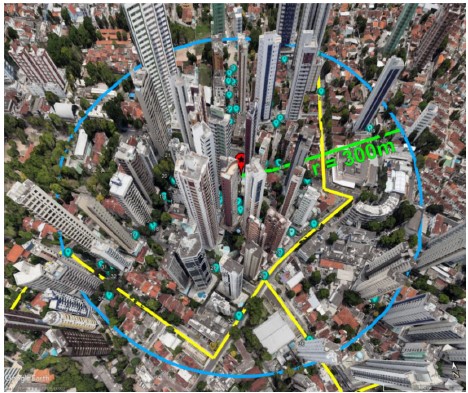 |
||||
| Figure 1. Location of the buildings researched. | ||||
An MS-Excel spreadsheet was initially created, with the information to be collected: building name and address, geographic coordinates, elevation between the base and top of the building, number of floors, estimated height, type of air support conditioning, condition of the supports (inspection), as the pathological manifestations (bad, regular and good) and the box model whether it is open or closed type and if they have already been replaced.
It was then defined to include only buildings above 3 floors, as low houses and buildings are more difficult to verify due to the high walls, not including public buildings, which were represented by dots and a blue numbering in order to be For easier cataloging of the information, these samples were collected over a period of 4 months by the computer and after this phase, a field visit was performed to verify some data not clarified during the first phase of collection and consequently to complete the worksheet. with the data of pathological manifestations identified and if after the construction of the building there were already replacements.
3. Analysis of the buildings
3.1. Types of air conditioning brackets
After gathering information, it was possible to identify 3 types of support systems for refrigeration appliances, which are: reinforced concrete protective boxes (window type), others supported by windows or spans (adopted as a hidden model) and the use of structures already incorporated into the building (split model), thus reaching a total of 61 buildings analyzed, Figure 2.
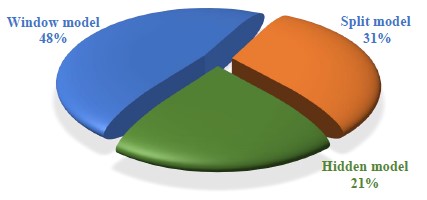 |
||||
| Figure 2. Building cooling system support systems. | ||||
Thus, it was found that 48% of buildings use window type models, 21% with the hidden model and finally, with only 31% the models that integrate the structures of buildings (split appliances), by the way come from latest projects.
What can be highlighted from the collected data is the existence of two models of window-type reinforced concrete protectors, out of a total of 29, 20 for the open model and 9 for the closed model, for their characteristics and dimensions, one can consider the most open model fragile, that is, almost 70% of the buildings that have window-type reinforced concrete protector have the simplest model and therefore generate a higher risk of premature wear. Below are the models represented in Figures 3 and 4.
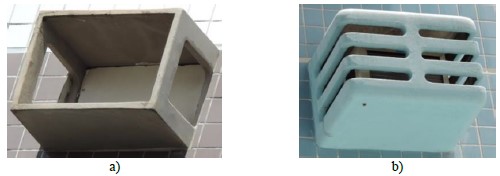 |
||||
| Figure 3. Reinforced concrete support, window type: a) open model; b) closed model. | ||||
 |
||||
| Figure 4. Other support models: c) hidden model; d) split model. | ||||
3.2. Structural design of window brackets
Below is the schematic representation of the open and closed models, Figure 5.
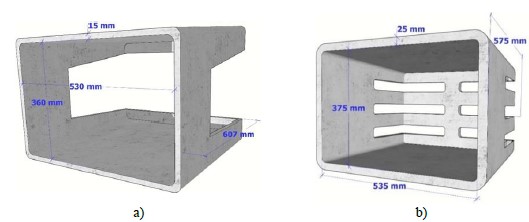 |
||||
| Figure 5. Structure of window type templates: a) open; b) closed. | ||||
Because the dimensions of the open model are quite simple, the manufacturing becomes easier, but the fragility of the structural model becomes visible.
There is the detail of a section of this model, which will identify the position of the reinforcement, in bracket wall, which in this case uses the 4.2 mm CA-60 reinforcing bar, this consideration, as stated in ABNT NBR 7480: 2007. According to (Oswaldo and Helene, 2001), CA-60 steel has a higher corrosion resistance than CA-50 steel due to its higher carbon and manganese content, associated with lower internal stresses of the structure, detail section can be seen on Figure 6.
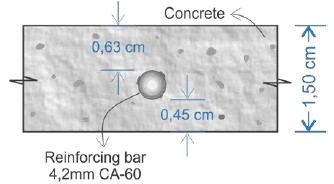 |
||||
| Figure 6. Reinforcing bar detail of open window model. | ||||
4. Results and discussion
4.1. Relative humidity / Atmospheric conditions
For this analysis it was collected through INMET - National Institute of Meteorology, Brazilian Climatological Normal 1981-2010 (INMET, 2018) and the city of Recife was separated during this period, based on the Relative Humidity Map of Compensated Air and the In two monthly and Annual Compensated Relative Air Humidity Spreadsheets, it was found that, based on the average, humidity ranged from 65% to 85% throughout the year, indicating humidity within the standards that accelerate corrosion processes, Figure 7.
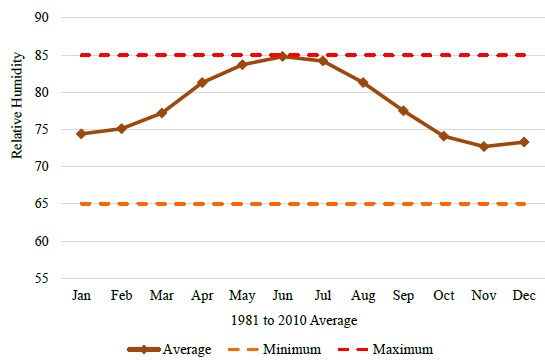 |
||||
| Figure 7. Relative humidity range (1981-2010), source: INMET. | ||||
According to the Brazilian Climatological Normal 1981-2010 (INMET, 2018), based on the Predominant Wind Direction Map (Cardinal and Collateral Points), there is a prevailing wind direction for the city of Recife, towards SE (southeast) in virtually every month of the year, except for November in the E (east) direction and July for the S (south) direction.
Using a residential building as an example, we used the Commander Compass Go 3.9.9 smartphone GPS app, using the gyro compass and the direction of the geographic coordinate inserted on the Google map, it was possible to visualize the direction of the windswept on the facades, year-round, Figure 8a.
This building has closed-model reinforced concrete protectors on all facades, but it can be seen that in the North (N) and West (W) facades, these structures tend to show more degradation, Figure 8b.
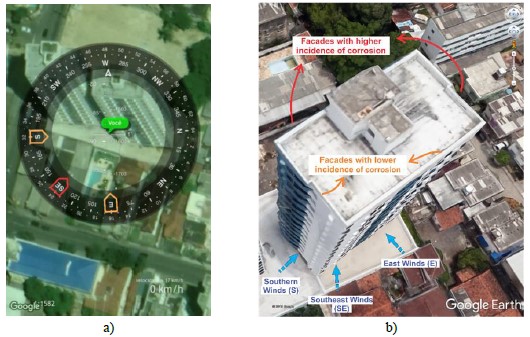 |
||||
| Figure 8. Wind direction building: a) wind direction in the year; b) winds in the building. | ||||
Some studies indicate that the wind speed, being higher than 3m/s, can distribute the chloride ions to regions farther from the coast, being also influenced by the altitude, with a higher concentration of chloride ions at lower altitudes, up to 10m, but in some regions, such as Hawaii, in the USA, can reach up to 30m., There are drastic reduction of these saline materials, (Meira, 2017) above these altitudes even in places where sea waves break. It has been identified that the wind presents a more decisive factor in the transport of chlorides into the concrete than the altitude, (Balestra, 2019) and which is larger up to 100m from the coast (Moreno, et.al., 2018).
Based on data from the BDMEP - Teaching and Research Weather Database, INMET, Average Wind Speed (mps) (INMET, 2018), it can be seen that over 5 years, the wind speed in Recife has not exceeded 2.75m/s, as a location of milder winds, Figure 9.
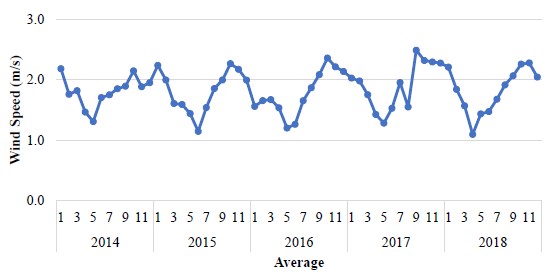 |
||||
| Figure 9. Wind speed (average), source: INMET. | ||||
4.2. Marine atmosphere
Because Recife is in a coastal region, close to the sea, the distance between the surveyed region and the breaking of the sea waves may indicate an attack of chloride ions (sea mist), Figure 10.
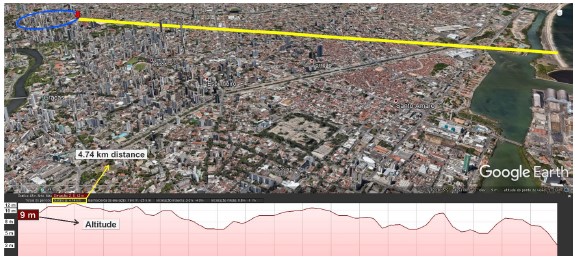 |
||||
| Figure 10. Distance from the analyzed region to the sea. | ||||
As can be seen, the distance from the breaking of the sea waves to the point under study, is around 4.74 km, according to (Pontes, 2006). After analyzing the seaside of the neighborhood of Boa Viagem in Recife, with measurements by the wet sail apparatus method for distances from 7 m to 320 m from the coast, where it was verified by an adopted model, that from 400 m there is a significant reduction in chloride deposition and boils down to tiny values at 700 m.
In another study by (Luna, 2008), on the Mapping of Atmospheric Corrosivity of the State of Ceará, it was concluded that this influence reaches distances of up to 30 km from the coast, that is, there are places with greater or lesser attack of chloride ions that can be very aggressive and with different morphologies (Moreno, et.al., 2015).
In a field analysis performed by (Meira, et.al., 2014), it was shown that the increase of concrete porosity, caused by the w/c ratio, causes a decrease in the amount of chloride ions inside the reinforced concrete.
4.3. Large population centers (pollution by aggressive agents)
The city of Recife concentrates a high population density, according to the 2010 Demographic Census of IBGE - Brazilian Institute of Geography and Statistics (IBGE, 2010), above 500 inhabitants per square kilometer, Figure 11, thus having one of the problems of the metropolises around the world: PM2.5 fine particulate matter pollution, formed by airborne solid or liquid particles (Ventura, et.al., 2017).
This was found to be within the appropriate WHO - World Health Organization parameters, which would be up to 400 ppm of carbon dioxide in the open environment, probably because it is related to the coastal region meteorological system, favoring the dispersion of these particles by air, according to (Santos, et.al., 2014), and having only a higher concentration in the rainy season.
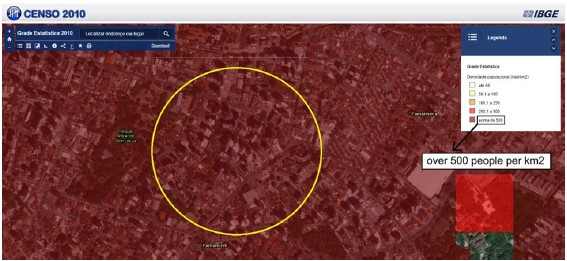 |
||||
| Figure11. Urbanization intensity, population density in Recife, PE. | ||||
5. Identification of pathological manifestations
After visiting cement artifact suppliers, it was found that the concrete traces were empirically performed, thus having no quality control over the water-cement ratio and consequently influencing the total void volume and pore size, facilitating the transport of water, chloride ions and CO2 in concrete.
A field visit was carried out to identify the most recurrent pathological manifestations through a survey and recording through images and data.
In the first analysis, there is the visualization of cracks and reinforcement corrosion, possibly caused by carbonation or chloride attacks, Figure 12, as well as the most advanced state of degradation, when the structure stood out, due to the expansion caused by the volume increase of reinforcement and consequent expulsion of concrete by tensile force (Choi, et.al., 2014), Figure 13.
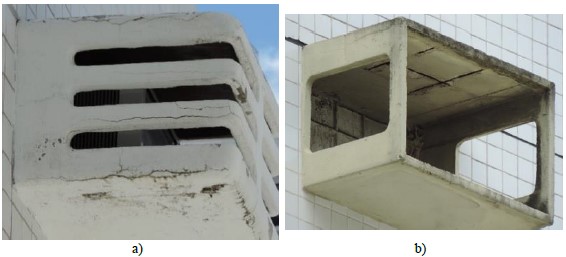 |
||||
| Figure 12. Reinforcement corrosion in window type model: a) fissures; b) concrete detachment. | ||||
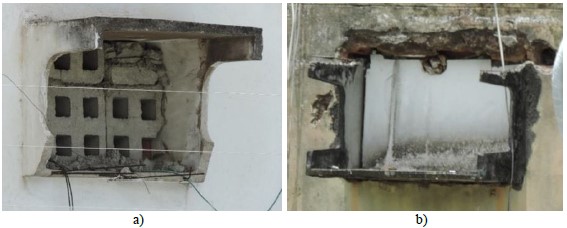 |
||||
| Figure 13. Partial break in open window model: a) absence of lower slab; b) absence of upper slab. | ||||
Another point to highlight and no less aggravating, is the improper use of these supports, situations created by the users or refrigeration technicians who, due to lack of knowledge or inability, make use of these supports to make modifications with the addition of another cooling system, which generate undersized efforts, favoring the infiltrations in the façade, overloading the
existing supports, already in the process of intense degradation, Figure 14.
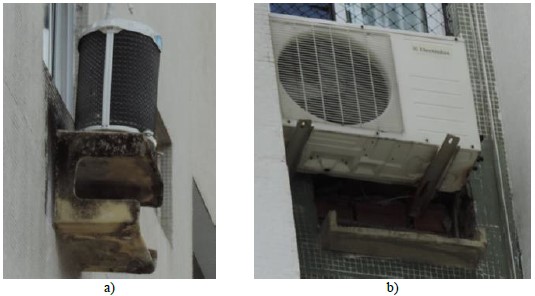 |
||||
| Figure 14. Improper Use: a) non-dimensioned efforts; b) facade infiltration. | ||||
For the buildings that have reinforced concrete supports, the main pathological manifestations were visually identified in the field, such as: mold, efflorescence, reinforcement corrosion and concrete detachment, Figure 15. From the 29 surveyed buildings, 11 had a history of replacement of these supports, of which 9 already had recurrence of some pathological manifestations, including detachment of the concrete.
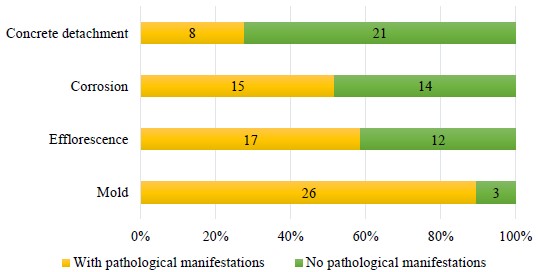 |
||||
| Figure 15. Pathological manifestations of reinforced concrete supports. | ||||
When analyzing closed-type models, their state of degradation is not easy to identify from the outside of the facades, since pathological manifestations tend to be more favorable on their internal face, leaving a margin of doubt as to their actual condition.
6. Risk analysis
After all the aggravating factors that accelerate the pathological manifestations, the questions inherent to the risk of this type of protector were analyzed, because in the face of the fragility generated by the degradations, the detachment of the façade (all or in part) may have a highly destructive impact in the soil.
Taking advantage of the calculation demonstrated by (Silveira, 2011), it was adopted for a 1kg object, considering the partial breakage of one support and another estimated weight of 25kg for a complete one, in a situation of detachment of the facades of the surveyed buildings and their respective heights.
Adopting Equation (1):
 |
(1) |
Which one has: F - force; M - body mass; g - acceleration of gravity; H - height; D - hardness of a concrete floor.
Figure 16 illustrates the information for the 1kg object in blue and 25kg in orange.
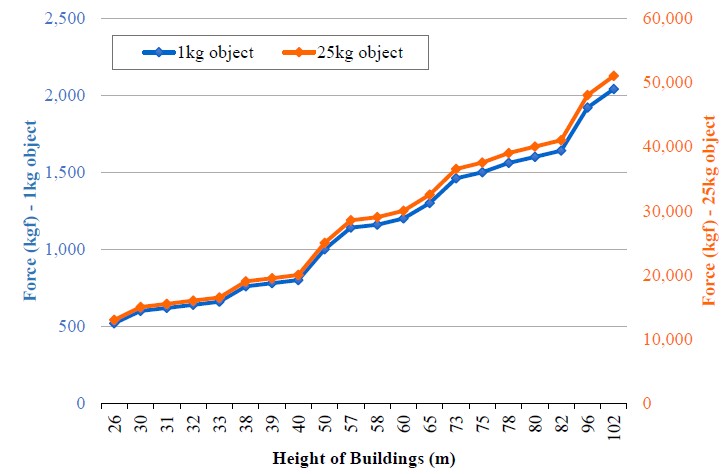 |
||||
| Figure 16. Force applied by the object in contact with the ground. | ||||
7. Recovery
This analysis aims to verify the viability of recovery of these supports, in order to increase their useful life, mainly related to the cases of corrosion of the reinforcement, since they have greater destructive power, not neglecting the other pathological manifestations of: mold, growth of vegetation, efflorescence, starting from the premise that resources will not be spent without a more robust justification, that is, there should be no maintenance of the facade just for cleaning and painting these supports.
For the recovery to be performed correctly, according to (Souza and Ripper, 1998), the need to remove the concrete that surrounds the reinforcement is considered, being considered thicknesses of 2 cm beyond the reinforcement, in order to ensure the total removal of the degraded concrete and return the reinforcement bars to alkaline condition, so that the cleaning and subsequent application of the grout are performed.
It is noteworthy that the wall thickness of the open model box prevents this execution, since the wall itself is only 1.5 cm thick, leaving this possibility of unfeasible recovery for the closed model box, although the dimensions are larger, neither allow a proper recovery, even if the condition is to remove only 1 cm from the concrete (without minimum standards and recommendations and with difficulty of execution), the possibility of cracking and breaking of the top are very large, because the structure itself is compromised, that is, in the case of this model, the possibility of recovery is also considered unfeasible, as shown in Figure 17.
It is noteworthy that in the market there are models with much more robust thicknesses of 4.5 cm to 6 cm of wall thickness, thus having a tighter control of concrete, these could be meeting the recommendations for greater durability.
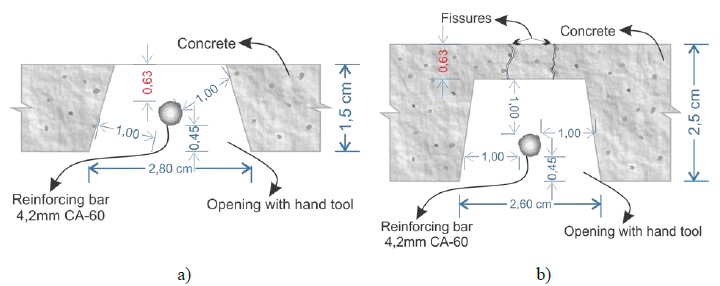 |
||||
| Figure 17. Detail of possible recovery: a) open model; b) model closed | ||||
8. Conclusions
Considering what has been observed, it is understood that the number of buildings with reinforced concrete supports are high, around almost 50%, and that they present pathological manifestations in almost all.
Some factors were more impacting on the degradation aspects, such as the low concrete quality, the high humidity throughout the year and the low concrete coating, favoring the acceleration of carbonation, in the case of carbon dioxide, which was within acceptable standards. open environment.
Although the attack by chloride ions is quite aggressive, it proved to be non-contributory, since the distance to the sea is over 100 m and the winds below 3 m/s.
The most common pathological manifestations were: mold, efflorescence, reinforcement corrosion and concrete detachment, respectively.
Replacements of reinforced concrete supports were identified in 38% of buildings that use this model and that in the survey, 27% show signs of concrete detachment, this is a decisive factor, since the impact of objects at high heights may impact to the ground in the order of tonnes of force.
Regarding the possibility of recovery, it was found that the supports do not offer the minimum acceptable repair conditions, as they do not have their own dimensions for such procedure.
9. Acknowledgements
This work was carried out with the support of the Higher Education Personnel Improvement Coordination - Brazil - (CAPES) - Financing Code 001.
10. References
Almeida, F. C. R., Sales, A. (2018), Ação do meio ambiente sobre as estruturas de concreto. In: Ribeiro D. V. et. al. “Corrosão e degradação em estruturas de concreto: teoria, controle e técnicas de análise e intervenção”. 2. ed. Elsevier, Rio de Janeiro, Brasil.
Associação Brasileira de Normas Técnicas (2007), NBR 7480: Aço destinado a armaduras para estruturas de concreto armado - Especificação. Rio de Janeiro, Brasil.
Associação Brasileira de Normas Técnicas (2014), NBR 6118: Projeto de estruturas de concreto - Procedimento. Rio de Janeiro, Brasil.
Balestra, C. E. T., et.al. (2019), “Contribution for durability studies based on chloride profiles analysis of real marine structures in different marine aggressive zones”. Construction and Building Materials 206:140-150. Elsevier. https://doi.org/10.1016/j.conbuildmat.2019.02.067
Bertolini, L. (2010), “Materiais de construção: patologia, reabilitação e prevenção”. Oficina de Textos, São Paulo, Brasil.
Fernández Cánovas, M. (1984), “Patología y terapéutica del hormigón armado”. Editorial Dossat, Madrid, España.
Choi, Y. S., et.al. (2014), “Effect of corrosion method of the reinforcing bar on bond characteristics in reinforced concrete specimens”. Construction and Building Materials 54:180-189. Elsevier. http://dx.doi.org/10.1016/j.conbuildmat.2013.12.065
Meira, G. R., et.al. (2014), “Analysis of chloride threshold from laboratory and field experiments in marine atmosphere zone”. Construction and Building Materials 55:289-298. Elsevier. http://dx.doi.org/10.1016/j.conbuildmat.2014.01.052
Meira, G. R., et.al. (2017), “Vertical distribution of marine aerosol salinity in a Brazilian coastal area - The influence of wind speed and the impact on chloride accumulation into concrete”. Construction and Building Materials 135:287-296. Elsevier. http://dx.doi.org/10.1016/j.conbuildmat.2016.12.181
Moreno, J. D., et.al. (2015), “Determining corrosion levels in the reinforcement rebars of buildings in coastal areas. A case study in the Mediterranean coastline”. Building Engineering 15:109-121. Elsevier. http://dx.doi.org/10.1016/j.conbuildmat.2015.09.059
Moreno, J. D., et.al. (2018), “Exposure of RC building structures to the marine environment of the Valencia coast”. Construction and Building Materials 100:11-21. Elsevier. https://doi.org/10.1016/j.jobe.2017.11.016
IBGE - Instituto Brasileiro de Geografia e Estatística (2018). “Cidades e Estados: Recife (PE)”. Brasília, Brasil. Disponível em: https://www.ibge.gov.br/cidades-e-estados/pe/recife.html. Acesso em: 13/06/2019.
IBGE - Instituto Brasileiro de Geografia e Estatística (2016). “Cidades e Estados: Recife (PE)”. Brasília, Brasil. Disponível em: https://www.ibge.gov.br/cidades-e-estados/pe/recife.html. Acesso em: 13/06/2019.
IBGE - Instituto Brasileiro de Geografia e Estatística (2010). “Cidades e Estados: Recife (PE)”. Brasília, Brasil. Disponível em: https://www.ibge.gov.br/cidades-e-estados/pe/recife.html. Acesso em: 13/06/2019.
IBGE - Instituto Brasileiro de Geografia e Estatística (2010). “Censo Demográfico 2010, Grade Estatística 2010”. Brasília, Brasil. Disponível em: http://mapasinterativos.ibge.gov.br/grade/default.html. Acesso em: 20/03/2019.
IBGE - Instituto Brasileiro de Geografia e Estatística (2002). “Mapa de clima do Brasil 1:5 000 000”. Brasília, Brasil. Disponível em: http://geoftp.ibge.gov.br/informacoes_ambientais/climatologia/mapas/brasil/Map_BR_clima_2002.pdf. Acesso em: 13/06/2019.
INMET - Instituto Nacional de Meteorologia (2018). “Normais Climatológicas do Brasil (1981-2010) - Direção Predominante do Vento (Pontos cardeais e colaterais)”. Brasília. Disponível em: http://www.inmet.gov.br/portal/index.php?r=clima/normaisclimatologicas. Acesso em: 18/06/2019.
INMET - Instituto Nacional de Meteorologia (2018). “Normais Climatológicas do Brasil (1981-2010) - Umidade Relativa do Ar Compensada”. Brasília. Disponível em: http://www.inmet.gov.br/portal/index.php?r=clima/normaisclimatologicas. Acesso em: 13/02/2019.
INMET - Instituto Nacional de Meteorologia (2018). “BDMEP - Banco de Dados Meteorológicos para Ensino e Pesquisa - Série Histórica - Dados Mensais - Velocidade do Vento Média (mps)”. Brasília. Disponível em: http://www.inmet.gov.br/portal/index.php?r=bdmep/bdmep. Acesso em: 24/06/2019.
Johnson, S. M. (1965), “Deterioration, maintenance, and repair of structures”. MCGraw-Hill, New York, USA.
Luna, A. M., et.al. (2008), “Mapeamento da Corrosividade Atmosférica do Estado do Ceará”. INTERCORR 2008. Recife, Brasil.
Cascudo, O., Helene, P. R. L. (2001), “Resistência à corrosão no concreto dos tipos de armaduras brasileiras para concreto armado”. Boletim Técnico da Escola Politécnica da USP, Departamento de Engenharia de Construção Civil, EPUSP, São Paulo, Brasil.
Pontes, R. B. (2006), “Disseminação de íons cloreto na orla marítima do Bairro de Boa Viagem, Recife/PE”, Dissertação Mestrado - Departamento de Engenharia Civil, Universidade Católica de Pernambuco, Recife, Brasil.
Santos, L. H. M., et.al. (2014), “Analysis of atmospheric aerosol (PM 2.5 ) in Recife city, Brazil”. Journal of the Air & Waste Management Association, 64:5, 519-528. https://doi.org/10.1080/10962247.2013.854282
Flores Larsena, S., Rengifob, L., Filippín, C. (2015), “Double skin glazed fac¸ ades in sunny Mediterranean climates”. Energy and Buildings 102:18-31. Elsevier. http://dx.doi.org/10.1016/j.enbuild.2015.05.019
Silveira, F. L. (2011), “Qual o peso equivalente que uma pedra de massa igual a 1 kg chega ao solo, jogada do 6 andar de um edificio?”. Centro de Referência para o Ensino de Física - CREF, UFRGS. 01 jun. 2011. Disponível em: https://www.if.ufrgs.br/novocref/?contact-pergunta=qual-o-peso-equivalente-que-uma-pedra-de-massa-igual-a-1-kg-chega-ao-solo-jogada-do-6-andar-de-um-edificio. Acesso em: 14 fev. 2019.
Souza, V. C., Ripper, T. (1998), “Patologia, recuperação e reforço de estruturas de concreto”. Pini, São Paulo, Brasil.
Perinia, K., Bazzocchib, F., Crocib, L., Maglioccoa, A., Cattaneo, E. (2017), “The use of vertical greening systems to reduce the energy demand for air conditioning. Field monitoring in Mediterranean climate”. Energy and Buildings 143:35-42. Elsevier. http://dx.doi.org/10.1016/j.enbuild.2017.03.036
Desai, V., Potter, R. (2014), “The Companion to Development Studies”. Routledge. Paignton. United Kingdom.
Ventura, L. M. B., et.al. (2017), “Chemical composition of fine particles (PM2.5): water-soluble organic fraction and trace metals”. Air Qual Atmos Health. Springer Science. http://dx.doi.org/10.1007/s11869-017-0474-z
